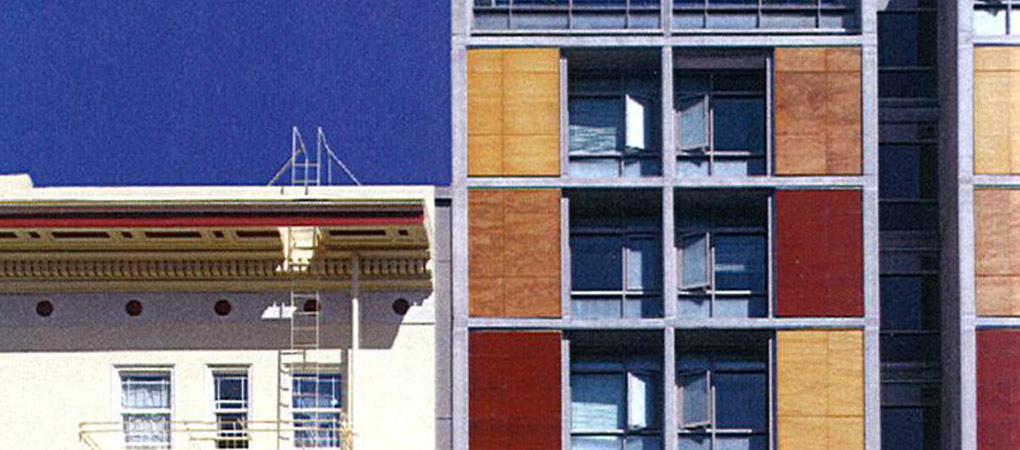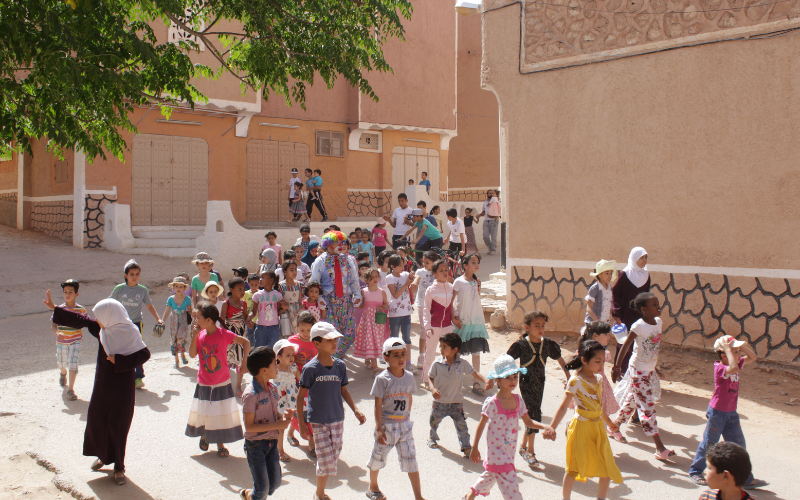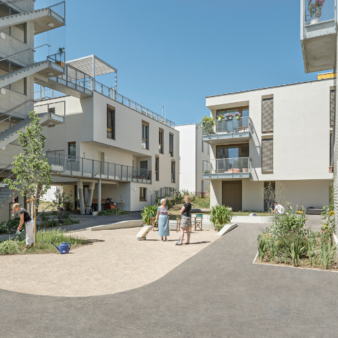Located in the heart of San Francisco, this environmentally responsible, mixed-use development provides homes and support to 106 low-income individuals, many of whom were chronically homeless and have complex medical and behavioural issues. Fully equipped studio apartments encourage independent living and the supportive environment and ongoing capacity-building programme aims to improve the health, mental and financial-wellbeing of Plaza residents.
Project Description
Aims and Objectives
- To promote environmentally-appropriate design in affordable housing construction in San Francisco.
- To develop a socially and environmentally sustainable approach that provides permanent, supportive housing for chronically homeless individuals in an inviting, stable and healthy environment.
- To achieve social impact, financial feasibility, design excellence, urban revitalisation and outreach and education.
- To demonstrate how housing chronically homeless individuals in services-enriched housing developments not only provides a greater opportunity for permanent stabilisation, but also reduces the city’s overall costs of servicing the homeless population.
Project context
The Public Initiatives Development Corporation is a non-profit community development corporation created in 2002 by the San Francisco Redevelopment Agency. It was established to enhance the city’s affordable housing delivery as part of its Earthquake Recovery Plan for the neglected South of Market Area (SOMA), compensating for the loss of housing and economic opportunities caused by the 1989 Loma Prieta Earthquake.
There are approximately 3,000 chronically homeless in San Francisco, making up only a fraction (between 10 and 25 per cent) of the city’s homeless population. The chronically homeless are those that remain on the streets for years at a time, and many suffer from concurrent substance abuse and chronic medical and mental health conditions. Chronically homeless individuals continually use city services: shelters, paramedics, emergency services, hospitals and clinics. This costs the city between US$60,000 and US$100,000 a year per individual.
Key features
Completed in March 2006, Plaza Apartments provides 106 homes for low-income individuals in San Francisco, many of whom were formerly homeless. The renovation and redevelopment of the site occupied by the old Plaza Hotel into the nine-story Plaza Apartments was designed by Leddy Maytum Stacy and Paulett Taggart Architects, and carried out in collaboration with the PIDC.
Building on the Single Room Occupancy (SRO) model that provides critical affordable housing for low-income individuals in urban areas, Plaza Apartments is the first example of a new SRO apartment building developed for the purpose of housing the chronically homeless. The project’s focus was the redevelopment of a 32 x 25 metre site occupied by the old Plaza Hotel, a two-storey substandard building with ground floor retail space, including a non-for-profit community theatre and 37-unit SRO residential facility for low-income individuals. Rooms in the old Plaza Hotel were approximately 12m² with two shared bathrooms, no kitchen facilities, and no community, social services or support spaces within the building.
The project has provided 106 affordable mini-studio apartments, comprehensive support services, residential amenities including community spaces, a roof deck with communal laundry and a courtyard area, commercial space and a community theatre. Each 30m² studio apartment contains a platform bed, full bath and fully-equipped kitchenette, encouraging independent living in a supportive environment.
It is the first newly constructed property fully dedicated to the innovative Direct Access to Housing Programme (DAH) established by the San Francisco Department of Public Health in 1998 to provide permanent housing with on-site supportive services to chronically homeless adults. The DAH is a low threshold programme that accepts residents with active substance abuse disorders, serious mental health conditions and/or complex medical problems.
Changing policy, reducing costs
Provision of housing within Plaza Apartments costs approximately US$10,000 per year, per individual compared to city costs of between US$60,000 and US$100,000. Not only has the project resulted in better health and housing outcomes for the individuals through the provision of long term solutions, it has also greatly reduced the city’s overall costs of servicing the homeless population. These large cost savings can then be directed by the city to develop more supportive housing and to provide services for temporary and episodic homeless individuals.
Resident incomes range from between US$265 and US$800 per month. The average income is between 12 and 20 per cent of the area median income and far below poverty standards. Rents have been scaled according to circumstances, with an average rate of US$325. Ownership of the land is retained by the San Francisco Redevelopment Agency to ensure long-term affordability. Should residents succeed in obtaining employment and increasing their income, they remain eligible to continue living at the Plaza Apartments, although their rent increases.
The Plaza Apartments were designed with environmental sustainability as a priority. Sustainable design strategies employed in the project include the use of solar power, energy-efficient systems and the use of materials with low embodied energy. Anticipated to achieve the US Green Building Council’s LEED (Leadership in Energy and Environmental Design) SILVER rating, the project aims to serve as a model for future supportive housing whilst setting a new standard for environmentally-sustainable affordable housing in San Francisco.
Covering costs
The total development cost was US$22.7 million, of which construction costs totalled US$16.9 million. Land was provided through a ground lease with the San Francisco Redevelopment Agency and funding was obtained from a range of sources (DAH, Department of Public Health, the Mayor’s Care-not-Cash Initiative, Redevelopment Tax Increment funds, Pacific Gas, Electric Energy Star and a grant for sustainable design elements from Enterprise Green Communities). A construction loan of US$10.5 million from Citibank has been repaid with the proceeds from the sale of Federal Tax Credits allocated to the project as an affordable housing development.
Community involvement
Early on in the design process, the project team met on numerous occasions with the South of Market Project Area Committee (SOMPAC) and other interested community members, including some Plaza Hotel tenants, to discuss the evolution of the proposed design, and what amenities are most desired by the residential tenants. These discussions identified the desire for full private bathrooms, common spaces, privacy, a sense of ‘home’ and safety. All concerns and suggestions were taken into consideration in the completed design.
Impact
The project has resulted in dramatic improvements of the quality of life of the residents. For many, this way their first home in years. In addition, to having access to full support services, residents report improvements to health, a sense of security, the development of an extended family with staff and residents and the ability to trust people once again. The project has had a positive impact at street and neighbourhood level, with open retail and community spaces that contribute toward the visual and economic regeneration of the area.
Why is it innovative?
- Combination of environmentally sustainable strategies and social support services in an affordable housing development.
- Innovative approach to permanent supportive housing: this is the first example of a new SRO apartment building developed for the specific purpose of housing chronically homeless and disabled individuals.
- High-quality design, aesthetics and functionality, with spacious and inviting living spaces designed to bring people together.
- The project incorporates a range of innovative, environmentally sustainable building materials and energy-efficient systems.
- The layout and facade design provide a sense of individuality within a community-based environment.
- A landscaped courtyard on the ground floor integrates community activities with the outdoor space and provides a healthy ‘oasis’ away from the streets, whilst creating a direct connection with the more residential street.
What is the environmental impact?
The building systems and materials have been sourced locally or regionally and selected for their long-term durability and ease of maintenance. Many of the building materials such as steel framing, rebar and insulation are recyclable and/or made with recycled materials. The apartments are all finished with environmentally appropriate materials such as bamboo, linoleum and recycled rubber flooring, sustainably harvested wood doors and 45 per cent minimum recycled content carpet.
A range of energy-use reduction strategies have been incorporated into the project’s design:
- Energy-efficient light fixtures and appliances have been specified in all apartments and public spaces.
- The building has been oriented and designed to provide natural day lighting.
- Overhangs, setbacks and high-performance windows minimise heat gain.
- A ‘rain screen’ cladding system of wood/resin panels over rigid insulation increases energy efficiency and thermal comfort.
- Lighting controls, occupancy sensors and automated lighting controls reduce electricity use.
- Hydronic heaters with a central energy-efficient boiler system with variable frequency drives reduce energy consumption.
- Roof insulation of R-30 and an Energy Star roof coating reduce heat gain.
- The courtyard has been designed to directly filter rainwater to the soil below, minimising impact on the city’s storm water system.
- A photovoltaic solar energy generation system installed on the roof provides approximately 12 per cent of the electrical house loads and a monitoring system tracks the efficiency of the system as it harnesses the sun’s renewable energy.
- The project involves the redevelopment of an underutilised urban site.
One of the goals set for the project was to minimise waste during construction. Working with the contractor and the local waste collection company, the team was able to achieve a 98 per cent diversion of construction waste from landfill.
Is it financially sustainable?
The project has a current contract to provide rental assistance and supportive services to residents for a nine-year period. It is anticipated that the project will continue well beyond this. However, should the contract expire, there is a well-funded Operating Reserve account dedicated solely to the Plaza Apartments which will be able to provide subsidy to residents and cover moving costs to other affordable housing units if necessary, ensuring that their ability to remain housed is not in jeopardy. Ownership of the land has been retained by the San Francisco Redevelopment Agency to ensure long-term affordability.
The cost savings that have resulted from the environmentally-sustainable strategies employed in the project outweigh the one- to two-per cent increase in construction cost that such strategies represent. It is estimated that the project will reduce its operating costs by 26 per cent through its reduction in energy consumption. This will save US$ 16,000 per year. The solar energy generation photovoltaic system will save US$ 10,000.
The annual cost per resident of just under US$ 10,000 represents a significant reduction compared to the annual cost to the city for each chronically homeless individual which is between US$ 60,000 and US$ 100,000. These savings contribute to the financial sustainability of the city’s homeless programme enabling funds to be channelled elsewhere.
What is the social impact?
The project has facilitated greater community cooperation and integration by involving each resident in participation on a level suitable to the individual. Some of the residents have already begun volunteering, especially in the areas related to homelessness. Through the establishment of a Tenants’ Council, residents are encouraged to actively discuss ongoing management issues and community concerns with the property management company.
One of the goals of the Plaza Apartments is to improve the mental and financial well-being and health of the residents. The support services offer ongoing capacity-building support for Plaza residents, including access to employment training opportunities, financial management and support in obtaining employment.
Chronically homeless individuals commonly develop health problems that are uniquely related to living on the street and, in many cases, to substance abuse. Severe chronic health conditions (pneumonia, lung abscess, and other infections) are exacerbated and propagated in overcrowded shelters and unhealthy living conditions. The Plaza Apartments provide a healthy living environment with ample daylight and ventilation. To ensure good indoor air quality, all paints, adhesives and sealants have low or zero-VOC (volatile organic compounds) content and all cabinetry is formaldehyde free. Thermal comfort is achieved through the use of materials such as low-glare glass and insulation.
The Direct Access to Housing Programme works to reduce social inequalities by targeting and empowering the most vulnerable population in the city and has housed over 400 chronically homeless adults who had rarely, if ever, maintained stable housing.
Barriers
- A change in programme from housing for low-income residents to supportive housing for formerly chronically homeless occurred during the construction process. This change required the re-design of portions of the building to provide space for more intensive support services. This challenge was overcome through extensive team meetings which sought creative solutions and coordination of revised drawings with completed and ongoing work.
- The South Market Project Area Committee neighbourhood group was initially opposed to the proposed change from low-income to formerly homeless residents at the Plaza Apartments. Resistance to the project was overcome through ongoing, open communication, being responsive to concerns and incorporating community input to the largest possible extent.
- The public biding process can be a barrier to quality construction, as it often means that the owner/architect and the contractor begin the construction process in an adversarial relationship. Good construction documents and peer review resulted in a well-coordinated set of construction documents which helped mitigate problems.
Lessons Learned
- The design and development team began the pre-design process by looking closely at projects with any similarities in the area. In this way, many lessons were learned from other projects and incorporated into the Plaza Apartments.
- This particular target population faces a higher rate of physical disability, requiring a larger number of fully adapted units than is typically provided. In the case of Plaza Apartments, over 25 per cent of residents use a wheelchair for at least some of their mobility. A typical property of this kind would require that five per cent of units be fully accessible and initial planning for the Plaza was for seven per cent full accessibility. Grab bars were installed in 50 per cent of the units and future projects should be designed to exceed minimum accessibility code standards by at least 10 per cent.
- Photovoltaic systems are difficult to incorporate on urban high-density residential buildings with small “footprints” such as the Plaza Apartments. Due to its height, the roof is highly congested with mechanical and ventilation equipment, making it difficult to design and install a PV System to its highest efficiency. Future projects should weigh the challenges and benefits of renewable energy production on-site before incorporating it into the development programme.
Evaluation
The Plaza Apartments project has recently completed its first year programme monitoring review. The property management firm is also currently undertaking a ‘resident satisfaction survey’, which will be taken annually for the life of the programme. Partners, including Enterprise Community Partners Green Communities Initiative, have provided technical support to the team to prepare post-development data which will be shared with agencies and developers who work with them to fund similar projects. This will allow actual results to be weighed against projected performance outcomes, and the efficacy of certain strategies used in the project to be determined.
The Plaza Apartment team has developed an education and outreach programme for the diverse groups interested in obtaining more information about the project. The team schedules tours and presents the development at a wide variety of trade conferences and meetings. Over 40 tours of the building have taken place by different groups of affordable housing developers and lenders, city officials, environmental groups, architects and architecture students from around the United States as well as other countries.
Transfer
The project and constituent programmes are undergoing expansion. Similar supportive housing units for chronically homeless individuals have recently been developed as part of larger mixed housing projects. The local government is encouraging all affordable housing developers to follow the new Sustainable Affordable Housing Guidelines for the city, which use the Plaza Apartments as a standard.
The project is included in the US Department of Housing and Urban Development’s ‘Affordable Housing Design Advisor’ to promote sustainable design within the affordable housing development community.The project team has received many inquires about the project from around the world including the French Cultural Attaché and supportive services agencies from London and Sydney, amongst others. The Plaza has set a new standard for incorporating sustainable design strategies in to supportive and affordable housing, with strong potential for transfer to other contexts.
Partnership
Private sector, professional, state/regional government



